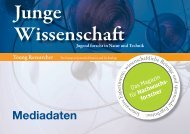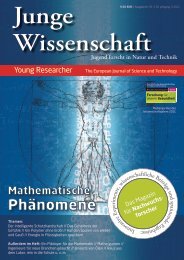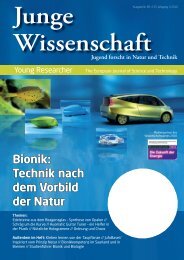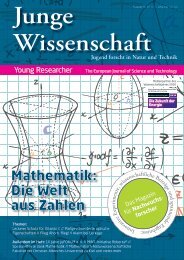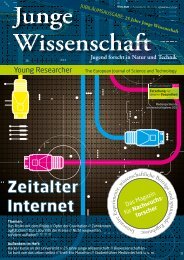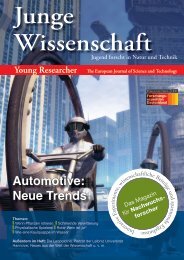2008: Das Jahr der Mathematik - Junge Wissenschaft
2008: Das Jahr der Mathematik - Junge Wissenschaft
2008: Das Jahr der Mathematik - Junge Wissenschaft
You also want an ePaper? Increase the reach of your titles
YUMPU automatically turns print PDFs into web optimized ePapers that Google loves.
<strong>Junge</strong><br />
Ausgabe Nr. 79 23. <strong>Jahr</strong>gang 01/<strong>2008</strong><br />
<strong>Wissenschaft</strong><br />
Young Researcher<br />
Jugend forscht in Natur und Technik<br />
The European Journal of Science and Technology<br />
<strong>2008</strong>:<br />
<strong>Das</strong> <strong>Jahr</strong><br />
<strong>der</strong> <strong>Mathematik</strong><br />
Im „Jugend forscht“-Teil:<br />
Frische Luft für Schüler Lösbarkeit von Sudokus<br />
Automatische Interaktion zwischen Computern<br />
Quantenpunkte in Pflanzen Short-term Adaption of<br />
Visual Areas Biologische Schädlingsbekämpfung mit Nematoden<br />
<strong>Das</strong> Magazin<br />
für Nachwuchsforscher<br />
spannende Ergebinsse:<br />
Innovative Experimente, wissenschaftlicheBeiträge und<br />
Außerdem im Heft: Alle Infos zum „<strong>Jahr</strong> <strong>der</strong> <strong>Mathematik</strong>“, Porträt <strong>der</strong> TU-Berlin, Neues aus <strong>der</strong> Welt<br />
<strong>der</strong> <strong>Wissenschaft</strong>, wichtige Termine für junge Forscher u. v. m.
Magazin<br />
Inhalt<br />
Vorwort/Impressum 3<br />
Inhalt 5<br />
Neues 6-10<br />
Kollektiver Schutz vor<br />
Parasiten im Ameisenstaat 6<br />
Schüler als Teilchenphysiker 7<br />
Fontänen-Atomuhren werden<br />
noch genauer 7<br />
Tauben schlafen ähnlich<br />
wie Menschen 8<br />
Coole Algorithmen und<br />
clevere Verfahren 9<br />
Drei rechnergesteuerten<br />
Hubschraubern gelingt<br />
gemeinsamer Lastentransport 9<br />
Sandburgen und ihr<br />
feuchtes Geheimnis 10<br />
<strong>Wissenschaft</strong>liche<br />
Veröffentlichungen finden 10<br />
Magazin - Teil I 11-16<br />
Termine 11<br />
<strong>Das</strong> <strong>Jahr</strong> <strong>der</strong> <strong>Mathematik</strong> 12<br />
Die Mathemacher 13<br />
Wie aus Zahlen Bil<strong>der</strong> werden 13<br />
MS <strong>Wissenschaft</strong>: Die<br />
schwimmende Ausstellung 14<br />
Porträt: Max Planck 16<br />
Jugend forscht 17-60<br />
Richtlinien für Beiträge 17<br />
Und sie verstehen sich doch! 18<br />
Transportvorgänge von<br />
Quantenpunkten in Pflanzen 24<br />
Short-term Adaption of Primary<br />
and High-or<strong>der</strong> Visual Areas 32<br />
Frische Luft für Schüler 38<br />
Wie viele Zahlen müssen<br />
es sein? 46<br />
Des einen Freund –<br />
des an<strong>der</strong>en Feind 52<br />
Magazin - Teil II 62-74<br />
Interview mit<br />
Prof. Günter M. Ziegler 62<br />
Der Ideenpark <strong>2008</strong> 65<br />
Wir haben die Ideen für<br />
die Zukunft: Die TU Berlin 68<br />
RoboKing 71<br />
Literaturtipps 73<br />
S. 11<br />
S. 18<br />
S. 24<br />
S. 32<br />
S. 38<br />
S. 46<br />
S. 52<br />
<strong>2008</strong>: <strong>Das</strong> <strong>Jahr</strong> <strong>der</strong> <strong>Mathematik</strong><br />
Auf unseren Son<strong>der</strong>seiten im Heft erwarten euch spannende<br />
Berichte und Informationen zum „<strong>Jahr</strong> <strong>der</strong> <strong>Mathematik</strong>“, denn<br />
die „<strong>Junge</strong> <strong>Wissenschaft</strong>“ begleitet das <strong>Jahr</strong> <strong>der</strong> <strong>Mathematik</strong><br />
als Medienpartner und berichtet somit über Ausstellungen, Aktionen,<br />
Wettbewerbe und Festivals des <strong>Wissenschaft</strong>sjahres.<br />
Und sie verstehen sich doch!<br />
Haben Computer unterschiedliche Betriebssysteme, brauchen<br />
sie einen Dolmetscher zur Verständigung. Ist dieser leistungsfähig,<br />
steht <strong>der</strong> gemeinsamen Bearbeitung von Rechenaufgaben<br />
nichts mehr im Wege.<br />
Autor: Wilhelm Blumberg<br />
Transportvorgänge von Quantenpunkten in Pflanzen<br />
Quantenpunkte sind Halbleiterteilchen mit einer Ausdehnung<br />
von etwa 2 bis 20 nm. Im Hinblick auf spätere medizinische Anwendungen<br />
wurde untersucht, wie sie sich in Pflanzen verhalten.<br />
Autor: Philip Kaib<br />
Short-term Adaption of Primary and High-or<strong>der</strong><br />
Visual Areas<br />
Optische Adaption tritt ein, wenn über lange Zeit <strong>der</strong> gleiche<br />
optische Reiz geboten wird. Entfällt <strong>der</strong> Reiz, ist die<br />
Wahrnehmung kurzzeitig gestört. Die Kurzzeitadaption primärer<br />
und höherer optischer Bereiche wurde untersucht.<br />
Autoren: Ilana Malekan, Yoni Smolin, Eszter Turi<br />
Frische Luft für Schüler<br />
Messungen des CO 2<br />
- und des O 2<br />
-Gehaltes sowie <strong>der</strong> Temperatur<br />
belegen, wie wichtig die Raumklimabedingungen für<br />
Schüler sind, um gute Leistungen zu erbringen.<br />
Autoren: Tobias Lutz, Daniel Szymchack<br />
Wie viele Zahlen müssen es sein?<br />
Je weniger Anfangszahlen ein Sudoku hat, umso schwieriger<br />
ist es. Aber wie viele müssen es mindestens sein?<br />
Autorin: Ariane Papke<br />
Des einen Freund – des an<strong>der</strong>en Feind<br />
Fadenwürmer (Nematoden) werden zur biologischen Schädlingsbekämpfung<br />
einsetzt. Um dies zu optimieren, wird die<br />
Reaktion auf Mehlwürmer und Wachsmottenlarven untersucht.<br />
Autorin: Vivien Miriam Rohwed<strong>der</strong><br />
4<br />
<strong>Junge</strong> <strong>Wissenschaft</strong> 79 // 1/<strong>2008</strong> // Inhalt
Magazin<br />
S. 62<br />
S. 65<br />
S. 68<br />
Interview mit Günter M. Ziegler,<br />
Professor am Institut für <strong>Mathematik</strong> <strong>der</strong> TU Berlin<br />
Günter M. Ziegler, <strong>Jahr</strong>gang 1963, ist Professor am Institut für<br />
<strong>Mathematik</strong> <strong>der</strong> Technischen Universität Berlin. Als Koordinator<br />
des <strong>Mathematik</strong>jahres <strong>2008</strong> setzt er sich dafür ein, seine<br />
Begeisterung für die Welt <strong>der</strong> Zahlen und Formeln jungen Menschen<br />
näher zu bringen...<br />
Mehr Lust auf Technik: <strong>der</strong> Ideenpark <strong>2008</strong><br />
Der IdeenPark ist <strong>der</strong> Höhepunkt <strong>der</strong> Initiative „Zukunft Technik<br />
entdecken“. Vor dem Hintergrund des zunehmenden Nachwuchsmangels<br />
in technischen Berufen versucht Initiator<br />
ThyssenKrupp bereits seit 2004, junge Menschen für Technik<br />
zu begeistern und sie zu einem ingeneurwissenschaftlichen<br />
Studium o<strong>der</strong> einer technischen Berufsausbildung zu motivieren.<br />
Die TU Berlin stellt sich vor<br />
Die Technische Universität Berlin ist eine <strong>der</strong> größten technischen<br />
Universitäten Deutschlands. Mehr als 28.000 Studierende<br />
bildet die Hochschule in rund 70 Studienfächern<br />
aus. Der Schwerpunkt liegt dabei klar auf den technologisch<br />
orientierten Studienfächern wie <strong>Mathematik</strong>-, Natur- und<br />
Ingenieurwissenschaften.<br />
<strong>Junge</strong> <strong>Wissenschaft</strong>-<br />
Jugend forscht in Natur und Technik<br />
<strong>Junge</strong> <strong>Wissenschaft</strong> veröffentlicht<br />
Originalbeiträge junger Autoren bis zum<br />
Alter von 23 <strong>Jahr</strong>en mit anspruchsvollen<br />
Themen aus allen Bereichen <strong>der</strong> Naturwissenschaften<br />
und Technik.<br />
Gründungsherausgeber:<br />
Prof. Dr. rer. nat. Paul Dobrinski<br />
Beirat:<br />
Dr. J. Georg Bednorz<br />
Nobelpreisträger<br />
IBM Research Division<br />
Forschungslaboratorium Zürich<br />
Prof. Dr. rer. nat. Dr. h. c.<br />
Manfred Eigen<br />
Nobelpreisträger, Max-Planck-<br />
Institut für Biophysikalische Chemie,<br />
Göttingen<br />
Wie aus Jungforschern junge <strong>Wissenschaft</strong>ler werden<br />
Prof. Dr. Ernst O. Göbel<br />
Präsident <strong>der</strong> Physikalisch-<br />
Technischen Bundesanstalt,<br />
Braunschweig und Bonn<br />
Sie sind nicht älter als 23 <strong>Jahr</strong>e und haben<br />
gerade in <strong>der</strong> Schule, z. B. im Rahmen von<br />
Jugend forscht, o<strong>der</strong> im Studium eine eigene<br />
Forschungsarbeit durchgeführt? Haben<br />
Sie schon einmal darüber nachgedacht,<br />
was mit Ihren Ergebnissen jetzt passiert<br />
– wie aus einem jungen Forscher ein junger<br />
<strong>Wissenschaft</strong>ler werden kann? Denn es gilt:<br />
„Forschen ohne Veröffentlichen ist keine<br />
<strong>Wissenschaft</strong>“.<br />
Die Zeitschrift <strong>Junge</strong> <strong>Wissenschaft</strong> ist für<br />
Sie das geeignete Forum, um Ihre Ergebnisse<br />
wissenschaftlich zu veröffentlichen.<br />
Und das geht wie folgt:<br />
Auf Seite 23 im „Jugend forscht“-Teil<br />
sind die Kriterien aufgeführt, die das reibungslose<br />
Veröffentlichen Ihrer wissenschaftlichen<br />
Beiträge ermöglichen. Hier<br />
finden Sie wichtige Hinweise, wie die Arbeit<br />
aufgebaut sein soll, wie lang die Arbeit<br />
sein darf, wie die Bil<strong>der</strong> einzureichen<br />
sind und welche weiteren Informationen<br />
wir benötigen. Dann schicken Sie die Arbeit<br />
an die Redaktion. Von dort wird die<br />
Arbeit an Fachgutachter weitergeleitet,<br />
welche die inhaltliche Richtigkeit <strong>der</strong> Aussagen<br />
begutachten. Gelegentlich ergeben sich<br />
daraus Hinweise, wo noch etwas verbessert<br />
werden kann, was dann an den Autor weitergeleitet<br />
wird. Schließlich kommt die Arbeit in<br />
die Redaktion, wird für das Layout vorbereitet<br />
und veröffentlicht.<br />
Was haben Sie davon?<br />
Ihre Forschungsarbeiten sind nun in einer<br />
Gutachterzeitschrift (peer reviewed journal)<br />
veröffentlicht worden, d. h. Sie können die<br />
Veröffentlichung in Ihre wissenschaftliche<br />
Literaturliste aufnehmen.<br />
Die <strong>Junge</strong> <strong>Wissenschaft</strong> wird in wissenschaftlichen<br />
Datenbanken gelistet, d. h.<br />
Ihre Arbeit kann von Experten gefunden<br />
und beachtet werden.<br />
Sie selbst haben durch den Gesamtprozess<br />
eine ganze Menge gelernt: <strong>Das</strong> Erstellen<br />
einer wissenschaftlichen Arbeit. Dies<br />
werden Sie spätestens im Studium wie<strong>der</strong><br />
benötigen.<br />
Und schließlich erhalten alle jungen Autoren<br />
<strong>der</strong> <strong>Junge</strong>n <strong>Wissenschaft</strong> als Dankeschön<br />
ein <strong>Jahr</strong> lang ein Freiabonnement<br />
<strong>der</strong> Zeitschrift.<br />
Wir freuen uns auf Ihre Zuschriften:<br />
<strong>Junge</strong> <strong>Wissenschaft</strong><br />
Dr.-Ing. Sabine Walter<br />
Schacht-Albert-Ring 52,<br />
30952 Ronnenberg<br />
s.walter@verlag-jungewissenschaft.de<br />
Dr. Uwe Groth<br />
Dr. Groth und Partner<br />
Unternehmensberatung<br />
VDI Projektleitung<br />
„Jugend entdeckt Technik“<br />
Prof. Dr. Elke Hartmann<br />
Universität Halle<br />
VDI Bereichsvorstand<br />
„Technik und Bildung“<br />
Dr. Uta Krautkrämer-Wagner<br />
Geschäftsführerin <strong>der</strong> Stiftung<br />
„Jugend forscht“ e.V.,<br />
Hamburg<br />
Prof. Dr. Bernd Ralle<br />
Schriftführer <strong>der</strong> Zeitschrift MNU,<br />
Fachbereich Chemie,<br />
Universität Dortmund<br />
Wolfgang Scheunemann<br />
Geschäftsführer <strong>der</strong> dokeo GmbH,<br />
Stuttgart<br />
Young Researcher 5
Jugend forscht<br />
Jugend forscht<br />
Short-term Adaption of Primary<br />
and High-or<strong>der</strong> Visual Areas<br />
A Psychophysical Experiment<br />
Visual adaptation is a known phenomena induced when the visual system is exposed to the same stimulus for a<br />
prolonged time. When the stimulus is turned off one of the systems’ calibration mechanisms are caught off-guard and<br />
visual perception is briefly perturbed. In our study, we conducted for the first time a psychophysical experiment on<br />
short-term adaptation of primary and high-or<strong>der</strong> visual areas.<br />
1 Introduction<br />
Vision is the most dominant sensory modality<br />
of primates. When light enters the eye,<br />
photoreceptors in the retina transform the<br />
energy into electrical signals. These signals<br />
are then sent by interneurons to ganglion<br />
cells. The fibers of the ganglion cells cross at<br />
the optic chiasm and terminate in the lateral<br />
geniculate nucleus (LGN). Visual information<br />
is then transferred to the primary<br />
visual cortex (V1). V1 is one of the most<br />
studied cortical areas, it is also called<br />
the striate cortex or area 17, located in the<br />
occipital lobe at the back of the brain, two<br />
millimeters thick and densely packed with 6<br />
layers of cells.<br />
From V1, information is sent to other areas<br />
of the visual cortex for further, higher analysis.<br />
Visual information is then divided into<br />
two paths known as the ventral and dorsal<br />
stream. The ventral “what” stream controls<br />
recognition, object representation and memory<br />
while the dorsal “where” stream runs<br />
motion and object locations.<br />
A variety of experimental procedures has<br />
been developed for demonstrating the<br />
cortical architecture and the unique pattern<br />
of activation for each group of cells.<br />
In their pioneering electrophysiological<br />
studies of monkeys and cats, Hubel and<br />
Wiesel worked out the appropriate light<br />
stimuli for various cortical cells [5]. It was<br />
found that V1 has neurons with elongated<br />
receptive fields which respond best to simple<br />
stimuli such as bars, lines and edges. V1<br />
neurons also have spatial-frequency<br />
seletivity and respond to luminance changes.<br />
Visual cortical neurons are highly tuned and<br />
specialized for processing a certain aspect of<br />
Autoren<br />
Ilana Malekan, *1989<br />
Muttontown, NY, USA<br />
Yoni Smolin,*1988<br />
Nazareth Illit., Israel<br />
Eszter Turi, *1987<br />
Csorna, Ungarn<br />
Teilnehmer am Scitech 2005 des<br />
Technion, Haifa, Israel<br />
Eingang <strong>der</strong> Arbeit: März 2007<br />
Zur Veröffentlichung empfohlen:<br />
April 2007<br />
32<br />
<strong>Junge</strong> <strong>Wissenschaft</strong> 79 // 1/<strong>2008</strong> //<br />
Short-term Adaption of Primary and High-or<strong>der</strong> Visual Areas
Jugend forscht<br />
Jugend forscht<br />
visual information such that any given<br />
neuron only responds to a subset of stimuli<br />
in its receptive field.<br />
Recognizing an object in the human brain<br />
takes only a fraction of a second. The neural<br />
mechanisms un<strong>der</strong>lying this remarkable<br />
ability are not well un<strong>der</strong>stood. Until the<br />
mid-1990s, little was known about the functional<br />
organization of human visual cortex.<br />
This landscape has changed dramatically with<br />
the invention of functional magnetic resonance<br />
imaging (fMRI), a powerful tool for<br />
the noninvasive mapping of the normal human<br />
brain.<br />
Recent studies have shown that there are<br />
regions in the cortex which specialize in specific<br />
visual stimuli recognition. Using fMRI<br />
techniques, Malach and colleagues delineated<br />
an area that showed a preferential activation<br />
to images of objects, compared to a wide range<br />
of texture patterns [9]. This area was termed<br />
the lateral occipital cortex (LOC).<br />
Kanwisher and co-workers have suggested<br />
that this area and some other regions located<br />
at the ventral temporal cortex, contain a limited<br />
number of modules specialized in specific<br />
category recognition such as faces (fusiform<br />
face area; FFA), places (parahippocampal<br />
area; PPA), and body parts (extrastriate body<br />
part area; EBA). ([6]; [10], [11].<br />
Vision is the most dominant sensory modality<br />
of primates. The visual system is almost<br />
constantly exposed to new images and thus<br />
it is forced to adjust the visual coding to the<br />
characteristics of the image currently presented.<br />
Visual adaptation is a known phenomenon<br />
induced when the visual system is<br />
exposed to the same stimulus for a prolonged<br />
time. Processes of visual adaptation manipulate<br />
the sensitivity of the cells in the visual<br />
cortex. Exposure to an adapting pattern for<br />
several seconds causes a decrease in the sensitivity<br />
of neurons tuned to the pattern’s specific<br />
properties. This phenomenon lasts a few<br />
more seconds after the stimulus is turned off,<br />
and thus defines the adaptation effect. In that<br />
period the exposed subject recalls striking<br />
changes in the perception of shape, color<br />
and motion. Adaptation involves a variety of<br />
visual attributes and stages of visual processing.<br />
why our perception is briefly perturbed.<br />
Very little is known though about short-term<br />
adaptation.<br />
Our project is divided in two parts: we intend<br />
to contribute to a better un<strong>der</strong>standing of<br />
short-term adaptation mechanisms in – on the<br />
one side – primary visual areas and – on the<br />
other side – in high or<strong>der</strong> face-related visual<br />
areas. As we can see clearly, there is a hot debate<br />
on the neural mechanisms that are fundamental<br />
to face perception and yet, a major<br />
consensus regarding cortical areas that are<br />
most activated by viewing faces.<br />
We, therefore, used 2D geometrical shapes<br />
with grayscale grating pattern and 2D<br />
grayscale face images as the most captivating<br />
and tuned stimuli. Our main assumption was<br />
that short-term adaptation affects the ability<br />
to receive and analyze new coming stimuli. In<br />
or<strong>der</strong> to prove it, we conducted a psychophysical<br />
experiment testing the impact of<br />
short-term adaptation on subjects' ability to<br />
distinguish changes in contrast and figural<br />
properties of a stimulus.<br />
2 Methods<br />
Two psychophysical experiments were conducted<br />
which were aimed to find out the influence<br />
of short-term adaptation on the ability<br />
to note minor changes in the presented<br />
stimuli. It is important to note that without<br />
adaptation those modifications could be easily<br />
detected. The experiments were conducted<br />
serially as the or<strong>der</strong> was controlled.<br />
2.1 Participants<br />
Twenty subjects (eight males and twelve<br />
females) participated in the experiment, five<br />
of them were eliminated (two males and three<br />
females) due to some environmental factors<br />
while conducting the experiment. All of them<br />
were students at the age of 16 - 33 years. All<br />
were regular users of computers and had normal<br />
or corrected-to-normal vision. Except for<br />
one, all the subjects were right-handed. The<br />
amount of sleeping hours during the night<br />
before the experiment varied between 4 - 9<br />
hours. Three of them have participated in psychophysical<br />
experiments before.<br />
2.2 Stimuli of the experiment on primary<br />
visual areas<br />
To examine the effect of short-term adaptation<br />
in primary visual areas, stimuli were chosen<br />
which most activate the primary visual cortex<br />
(Experiment A). While constructing our<br />
experiment we used motives resembling to<br />
those found in previous research dealing with<br />
long-term adaptation. These kinds of stimuli<br />
are proved to activate mainly primary areas in<br />
visual cortex. We used four different 2D geometrical<br />
shapes with grayscale grating pattern;<br />
each had four different types of modification<br />
(Fig. 1): the original image, same image with<br />
modified spatial frequency (figural modification),<br />
both with original and different level of<br />
contrast (contrast modification). All modified<br />
parameters were controlled such that in each<br />
image the modification level is comparable to<br />
the other.<br />
2.3 Stimuli of the experiment on highor<strong>der</strong><br />
visual areas<br />
As our second aim was to examine the effect of<br />
Long-term visual adaptation and its effects<br />
have been extensively studied for many years.<br />
It is known that due to adaptation, our brain<br />
is forced to bias any new information to<br />
alternative non-adapted neurons which is<br />
Figure 1: Experiment A: Bottom row-original images, upper row-different modifications a) no modifications,<br />
presenting the same image again. b) spatial frequency modification. c) contrast modification.<br />
d) a combined modification of both contrast and spatial frequency<br />
Young Researcher 33
Jugend forscht<br />
Jugend forscht<br />
For every stimulus four block types were created<br />
presenting only one kind of stimuli (with<br />
the needed modifications in the needed or<strong>der</strong><br />
according to the block type) in it. In the first<br />
block (type 1) adaptation was acquired by<br />
exposing the subject to the same image eight<br />
times. The second block (type 2) was composed<br />
of images with only minor changes. The<br />
third one (type 3) contained pictures with<br />
different aspects of modifications; original (nonmodified),<br />
spatial frequency modifications,<br />
contrast modifications and with modifications<br />
both in contrast level and in spatial frequency.<br />
The purpose behind this approach was that<br />
these changes interrupted the adaptation so we<br />
could use the fourth block (type 4) (which was<br />
quite similar to the second one concerning the<br />
types and numbers of different events) as a control.<br />
As the most important point was to have<br />
the first two and second two blocks to follow<br />
each other, we shuffled the blocks a bit so that<br />
our subject will not get bored and find any rules<br />
about the procedure of the experiment.<br />
Figure 2: Experiment B: Bottom row-original images, upper row-different modifications a) no modifications<br />
(presenting the same image again), b) face properties modification c) contrast modification d) a combined modification<br />
of both contrast and face-properties.<br />
short-term adaptation in high or<strong>der</strong> visual areas,<br />
we chose stimuli which most activate high<br />
or<strong>der</strong> visual cortex (Experiment B). As social<br />
primates, faces are the most common stimuli<br />
which we are exposed to in our life span.<br />
These kinds of stimuli are proved to activate<br />
mainly secondary areas in visual cortex. We<br />
decided to use unfamiliar faces to avoid any<br />
other effect. Four different images were used;<br />
each had four different types of modification<br />
(Fig. 2): the original image, a modified face,<br />
both with original and different level of contrast.<br />
Face modification was performed using<br />
‘Morphases’ program (www.morphases.com).<br />
All modified parameters were controlled such<br />
that in each image the modification level is<br />
comparable to the other.<br />
2.4 Presentation<br />
The experiments were conducted using ‘Presentation<br />
© ' program package.<br />
2.5 Procedure<br />
We were interested in the viewer's performances<br />
both in accuracy and speed aspects.<br />
Since there is a trade-off between the two, our<br />
instructions were to pay attention to both of<br />
them but accuracy should be more important<br />
than speed. Eight images were presented in a<br />
pseudo-random block sequence. Image presentation<br />
within each block was controlled in<br />
a way that preserves a constant ratio between<br />
different "events" (Fig. 3).<br />
Subjects were asked to perform ‘one-backmatch’<br />
task. The question to answer was to decide<br />
whether they consi<strong>der</strong> the presented image<br />
the same (pressing button ‘yes’), or they note<br />
any changes in the picture’s figural properties<br />
comparing to the previously presented image<br />
(pressing button ‘no’). We directed them to<br />
consi<strong>der</strong> only figural modification as remarkable<br />
change. As subjects were not informed<br />
about the aims of the block types, they were<br />
instructed to perform the task during the whole<br />
experiment.<br />
A fixation point was shown during the whole<br />
experiment. Visual epochs were alternated with<br />
5-s blanks. Four cycles of the stimulus were<br />
shown (one for each image). As we had altogether<br />
16 blocks the total time was 336s.<br />
3 Results<br />
Data analyses included several different aspects;<br />
all refer to the accuracy of performances regardless<br />
of subjects' response time.<br />
Figure 3: Experimental paradigm for experiment A (left) and B (right): (A) Four types of blocks (left to right): adaptation, control_1, adaptation interruption, control_2. (B) A segment from<br />
the time axis of the experimental run of an overall duration of 336s.<br />
34<br />
<strong>Junge</strong> <strong>Wissenschaft</strong> 79 // 1/<strong>2008</strong> // Short-term Adaption of Primary and High-or<strong>der</strong> Visual Areas
Jugend forscht<br />
Jugend forscht<br />
3.4 'Training' effect<br />
Half of the subjects participated first in the<br />
high-or<strong>der</strong> adaptation experiment and half of<br />
the subject participated first in the primaryvisual-areas<br />
adaptation experiment. For each<br />
subject the total accuracy level was calculated<br />
for both experiments and a total average was<br />
calculated. A minor improvement trend was demonstrated<br />
in the second experiment, regardless<br />
of experiment-type. This might be due to<br />
some 'training' effect, in which the subjects are<br />
more familiar with the task and thus achieve<br />
better performances.<br />
Figure 4: The percentage of change in accuracy between the second and the fourth blocks. A significant improvement<br />
in performances was indicated after interrupting adaptation.<br />
3.1 The influence of adaptation /<br />
interruption (of adaptation) on response<br />
accuracy<br />
The first block in both experiments was supposed<br />
to generate adaptation and the third one<br />
was supposed to interrupt adaptation. The second<br />
and fourth blocks were similar which enabled<br />
us to use them as internal controls. We,<br />
therefore, focused on the responses given in the<br />
second and fourth block, assuming that significant<br />
differences in performances between these<br />
two homologue blocks result from the primer<br />
block.<br />
Experiment A: As we can see in figure 4, in<br />
73 % of the events, the subjects’ ability to note<br />
minor changes in the displayed picture is increasing<br />
after the interrupting block. In 18 % of<br />
the events, the value of accuracy remained the<br />
same and in 9 % of the events accuracy level<br />
decreased.<br />
The properties of the first error after adaptation<br />
effect were investigated. It was found that in<br />
both experiments errors due to changes in contrast<br />
level were the most dominant (see Fig. 6).<br />
3.3 Comparison of the two experiments<br />
First of all, we compared the number of errors<br />
in the two experiment types. The average percentages<br />
of total errors did not show any significant<br />
differences.<br />
We also compared the average percentages of<br />
errors due to different contrast levels. As it can<br />
be seen, the errors due to contrast levels in both<br />
the primary and high-or<strong>der</strong> experiment had no<br />
significant difference (see fig 7).<br />
4 Discussion<br />
There have been many studies on adaptation<br />
effects using fMRI but hardly any psychophysical<br />
experiments on short-term adaptation.<br />
The study of short-term adaptation is important<br />
because it can aid in un<strong>der</strong>standing neuronal<br />
mechanisms better and can also help scientists<br />
in mapping the functional properties of<br />
cortical neurons. The behavioral analyses performed<br />
in this experiment, which successfully<br />
showed adaptation, can be carried out through<br />
fMRI for a more detailed description of un<strong>der</strong>lying<br />
neuronal activity. The experiment proved<br />
adaptation occurred when the subject responded<br />
to the second block of images less accurately<br />
after looking at a repeated image than<br />
after looking at a block with altered images.<br />
This adaptation, indicated by other scientists,<br />
was due to fatiguing neurons responding less<br />
than normal.<br />
We assumed that the response time of a subject<br />
after acquiring adaptation would grow due to<br />
the conflict between the adapting stimulus and<br />
Experiment B: The same analysis was done on<br />
the data <strong>der</strong>ived from Experiment B, where we<br />
found that in 65 % of the events the subjects’<br />
ability to note minor changes in the displayed<br />
picture is increasing after the interrupting<br />
block. In 22 % of the events, the value of accuracy<br />
remained the same and in 13 % of the<br />
events accuracy level decreased.<br />
3.2 Error analysis<br />
Tracing the most confusing event, we examined<br />
the distribution of error types in experiment A<br />
and B. From these results (see Fig. 5) it can be<br />
clearly seen that in both experiments most of<br />
the errors were due to contrast modifications.<br />
Figure 5: Distribution of error types. The total number of errors was analyzed according to its "event" type. The percentage<br />
of each group was calculated for each subject separately and was averaged across subjects.<br />
Young Researcher 35
Jugend forscht<br />
Jugend forscht<br />
short-term adaptation effect are similar in both<br />
types of visual areas.<br />
References<br />
[1] Avidan, G., Hason, U., Hendler, T.,<br />
Zohary, A. and Malach, R., 2002: Analysis<br />
of the Neuronal Selectivity Un<strong>der</strong>lying<br />
Low fMRI Signals. Current Biology. 12:<br />
964-972.<br />
Figure 6: Percentage of the errors in first exposure to modified image after acquiring adaptation (block 2). Two different<br />
optional error types: caused due to an image modification or a contrast modifications.<br />
[2] Barrett, B. T., McGraw P. V. and<br />
Morril, P., 2002: Perceived Contrast Following<br />
Adaptation: The Role of Adapting<br />
Stimulus Visibility. Spatial Vision. 16:<br />
5–19.<br />
[3] Carandini, M., 2000: Visual Cortex:<br />
Fatigue and Adaptation. Current Biology.<br />
10. No 16.<br />
[4] Grill-Spector, K., 2003: The Neural<br />
Basis of Object Perception. Current Opinion<br />
in Neurobiology. 13. 1–8.<br />
[5] Hubel, D. H. and Wiesel, T. N, 1968:<br />
Receptive fields and functional architecture<br />
of monkey striate cortex. J. Physiol.<br />
195: 215-243.<br />
Figure 7: Percentage of the errors in first exposure to modified image after acquiring adaptation (block 2). Two different<br />
optional error types: caused due to an image modification or a contrast modifications.<br />
the changed ones. We collected information<br />
about response times during the experiment<br />
but did not analyze it in or<strong>der</strong> to face this question,<br />
which remains open for further research.<br />
5 Conclusion<br />
We showed for the first time that short-term<br />
adaptation behavior achieved by the psychophysical<br />
experiment is correlated with the results<br />
achieved by long term adaptation experiments,<br />
and also consistent with results achieved<br />
in fMRI-adaptation experiments.<br />
Due to time limitations, only the accuracy aspect<br />
of our results was analyzed. This aspect<br />
of the results is compatible with our basic assumption:<br />
Short-term adaptation causes a decrease<br />
in the accuracy of reaction to changes<br />
in stimuli. The most ambiguous behavior was<br />
demonstrated after contrast modifications. It<br />
was found that errors due to changes in contrast<br />
level were most dominant, and thus imply<br />
that the system is aware of some change but<br />
fails to specify it.<br />
Conducting two parallel researches, one dealing<br />
with "complex" stimuli, activating<br />
high or<strong>der</strong> cortical areas, and the other with<br />
"simple" stimuli, stimulating primary visual<br />
areas, we correlate the results of the studies. This<br />
unique comparison revealed a vast resemblance<br />
in the results of the two. We therefore suggest<br />
that the behavioral mechanisms un<strong>der</strong>lying<br />
Acknowledgement<br />
We would like to extend our most humble<br />
gratitude to our helpful, friendly, and<br />
inspiring mentor Anat Herbet-Grinfeld.<br />
We would also like to acknowledge the<br />
department of Biomedical Engineering<br />
for hosting us and SciTech staff for their<br />
hard work to provide us with this great<br />
summer camp. Eszter would like to thank<br />
the Hungarian Research Student Association<br />
(Kutató Diákok Országos Szervezete)<br />
and Mr. Russel Stern. Yoni would like to<br />
thank Simcha Stern. We would all like to<br />
thank our parents for granting us the opportunity<br />
to take part in this meaningful<br />
experience.<br />
[6] Kanwisher N., McDermott J., Chun<br />
M. M. – The fusiform face area: a module<br />
in human extrastriate cortex specialized<br />
for face perception. J. Neurosci 1997,<br />
17:4302-4311.<br />
[7] Luo, J., Crandall, D., Singhal, A.,<br />
Boutell, M. and Gray, R., 2003: Psychophysical<br />
Study of Image Orientation Perception.<br />
Spatial Vision. 16: 429-457.<br />
[8] Webster, M. A., 2001: Visual Adaptation<br />
and the Relative Nature of Perception.<br />
[9] Malach R., Reppas J. B., Benson R.<br />
R., Kwong K. K., Jiang H., Kennedy W.<br />
A., Ledden P. J., Brady T. J., Rosen R.,<br />
Tootell R. B. H. – Object-related activity<br />
revealed by functional magnetic resonance<br />
imaging in human occipital cortex. Proc.<br />
Natl. Acad. Sci. USA, Vol. 92 pp. 8135-<br />
8139, August 1995. Neurobiology -3.).<br />
[10] Epstein R., Kanwisher N. – A cortical<br />
representation of the local visual region.<br />
Nature 1998 Apr 9; 392 (6676): 598–601.<br />
[11] Downing PE., Jiang Y., Schuman M.,<br />
Kanwisher N. – A cortical area selective<br />
for visual processing of the human body.<br />
Science 2001 Sep 28;293(5539):2470.<br />
36<br />
<strong>Junge</strong> <strong>Wissenschaft</strong> 79 // 1/<strong>2008</strong> // Short-term Adaption of Primary and High-or<strong>der</strong> Visual Areas



